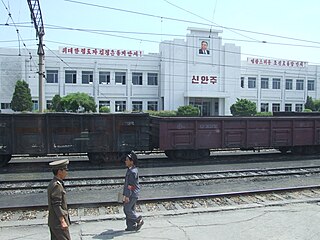
North Hwanghae Province is a province of North Korea. The province was formed in 1954 when the former Hwanghae Province was split into North and South Hwanghae. The provincial capital is Sariwon. The province is bordered by Pyongyang and South Pyongan to the north, Kangwon to the east, Kaesong Industrial Region and South Korea's Gyeonggi Province to the south, and South Hwanghae southwest. In 2003, Kaesong Directly Governed City became part of North Hwanghae as Kaepung County. Later on in 2019, it was promoted as Special City. Thus, it was separated from North Hwanghae.
Air Koryo is the state-owned flag carrier of North Korea, headquartered in Sunan-guyŏk, Pyongyang. Based at Pyongyang International Airport, it operates international scheduled and charter services to destinations within Asia as well as flights on behalf of the Government of North Korea.

Sinanju is the name of a region (신안주) in Anju city, South Pyongan Province, North Korea. The name literally means "Comfortable New Village." When Anju County was raised to the status of a city in August 1987, Sinanju Workers' District was divided into Sinwon-dong, Wonhung-dong, Yokchon-dong.

Pyongyang International Airport, also known as the Pyongyang Sunan International Airport, is the main airport serving Pyongyang, the capital of North Korea. It is located in the city's Sunan District. The airport has been closed since 2020 to international travel due to the COVID-19 pandemic, although international observers have suggested that the airport might be working to resume its international flights. Prior to its closure, the airport was serviced by flag carriers Air Koryo and Air China, serving only two foreign countries: China and Russia.

The Korean People's Army Air and Anti-Air Force is the unified military aviation force of North Korea. It is the second largest branch of the Korean People's Army comprising an estimated 110,000 members. It possesses around 950 aircraft of different types, mostly of decades-old Soviet and Chinese origin. Its primary task is to defend North Korean airspace.

The attack on the Sui-ho Dam was the collective name for a series of mass air attacks during the Korean War on thirteen hydroelectric generating facilities by United Nations Command air forces as part of the North Korean bombing campaign on June 23–24 and June 26–27, 1952. Primarily targeting the hydroelectric complex associated with the Sui-ho Dam in North Korea, the attacks were intended to apply political pressure at the stalled truce negotiations at Panmunjeom.
Sunan-guyŏk, or Sunan District is one of the 18 guyŏk that constitute Pyongyang, North Korea.

Samjiyŏn Airport is an airport in Samjiyon City, Ryanggang Province, North Korea.
Mirim Airport, also known as Pyongyang East Airfield or K-24 Air Base, is an airport in Mirim-dong, Sadong-guyok, Pyongyang-si, North Korea.
Panghyon Airport is an airport near Panghyŏn-dong in Kusong, Pyongan-bukto, North Korea.
Hwangsuwon Airport is an airport near Hwangsuwol-li in Kimhyonggwon-gun, Ryanggang-do, North Korea.
Koksan Airport is an airport near Koksan, Hwanghae-bukto, North Korea.
Kwail Airport(과일비행장) is an airport in Kwail, Hwanghae-namdo, North Korea.
Pyongsul Li Airport is an airport near Tŏkhŭng-ni in Koksan, Hwanghae-bukto, North Korea. Pyŏngsul-li village was named after Tŏkhŭng-ni in 1982.

Sondok Airport is an airport in Sŏndŏng-ni, Chŏngp'yŏng-gun, Hamgyong-namdo, North Korea.
Toksan Airport is an airport in Tŏksan-dong, Hamhŭng-si, Hamgyong-namdo, North Korea.
Pyongyang Air Base also known as Heijo Airfield or Pyongyang (K-23) Air Base was a former Imperial Japanese Army Air Service, Korean People's Air Force (KPAF) and United States Air Force (USAF) air base adjacent to the Taedong River in Pyongyang, North Korea. It was redeveloped after the Korean War as a Government and residential area.
The bombing of Pyongyang was conducted as part of a gradual and sustained U.S. aerial bombing of North Korea during the Korean War. By the time of the armistice, 75 percent of Pyongyang's area was destroyed by the bombing campaign, which was part of a broader U.S. bombing effort throughout the country.

The geology of North Korea has been studied by the Central Geological Survey of Mineral Resources, rare international research and by inference from South Korea's geology.
The UN offensive into North Korea was a large-scale offensive in late 1950 by United Nations (UN) forces against North Korean forces.







